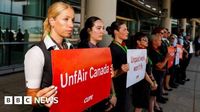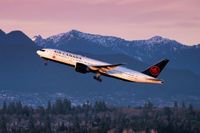Air Canada, the nation’s largest airline, is bracing for a complete shutdown of its mainline and Rouge operations as a looming flight attendants’ strike threatens to upend travel for hundreds of thousands during the peak summer season. The labor standoff, which has been simmering for months, escalated sharply this week after negotiations between Air Canada and the Canadian Union of Public Employees (CUPE) broke down, leading to a 72-hour strike notice and the airline’s decision to begin canceling flights on Thursday, August 14, 2025.
According to FlightAware, by Thursday morning, Air Canada had already canceled nine flights and delayed 69 more, with the numbers expected to rise rapidly. The airline announced plans to gradually wind down its operations over three days, culminating in a “complete cessation of flying by Air Canada and Air Canada Rouge” starting Saturday, August 16, at 1 a.m. ET. The impact is staggering: Air Canada typically flies about 130,000 passengers daily—including 25,000 Canadians returning from abroad—across 64 countries with its fleet of 259 aircraft. As the shutdown looms, the ripple effects are likely to be felt far beyond Canada’s borders, affecting international travelers and business alike.
The roots of the dispute lie in a protracted contract negotiation that has grown increasingly acrimonious. CUPE, which represents more than 10,000 Air Canada flight attendants, issued its strike notice on Wednesday, August 13, after more than eight months of bargaining ended in an impasse. The union says it has bargained in good faith, but that Air Canada “refused to address” core issues—most notably wages and the problem of unpaid work, such as time spent boarding passengers and waiting at airports. As CUPE national president Mark Hancock put it, “When we stood strong together, Air Canada didn’t come to the table in good faith. Instead, they called on the federal government to step in and take those rights away.”
Air Canada, for its part, contends that it offered a generous deal: a 38% increase in total compensation over four years, with a 25% raise in the first year. But the union flatly rejected the proposal, calling it “below inflation, below market value, below minimum wage,” and maintaining that the deal would still leave flight attendants unpaid for significant portions of their work. The issue of “ground pay”—compensation for work performed before takeoff and after landing—has emerged as a major sticking point. According to the union, Air Canada’s offer to pay ground work at 50% of the hourly rate falls short; CUPE is demanding full pay for all hours worked, arguing that members are struggling to pay rent and buy basic groceries.
The deadlock has drawn in the federal government, with Jobs Minister Patty Hajdu urging both sides to return to the bargaining table. However, the union has accused Hajdu of siding with Air Canada. “Every party has expressed support for our effort to end unpaid work except for the governing Liberal Party,” said Wesley Lesosky, president of the Air Canada component of CUPE, during a tense news conference. CUPE leaders claim that Hajdu “brought a ‘no’ from Air Canada to the bargaining table,” a move Hancock described as unprecedented in his experience dealing with governments across Canada. Hajdu, for her part, has stated, “I have met with both parties throughout the bargaining process and strongly urged them to come to an agreement.” She confirmed that Air Canada requested the dispute be referred to binding arbitration under Section 107 of the Canada Labour Code, but CUPE declined, preferring to continue direct negotiations.
The tension spilled over into public view on Thursday, when Air Canada’s press conference in Toronto was abruptly ended by protesting flight attendants holding signs that read “unpaid work won’t fly” and “UnfAir Canada.” The union’s resolve appears strong—earlier this month, 99.7% of its members voted in favor of a strike, underscoring the depth of frustration among frontline workers.
As the airline prepared for the shutdown, executives warned that restarting operations would not be quick or easy. “Air Canada is a very complex system,” said Mark Nasr, executive vice president and chief operations officer, during Thursday’s briefing. “It simply is not the kind of system we can start or stop at the push of a button.” Nasr estimated it would take about a week to fully resume regular service after any suspension.
Travelers have already begun to feel the disruption. Alanna Wolf, a passenger interviewed by CBC, said she rebooked her flight home to Toronto for Thursday instead of her original Saturday departure due to fears of being stranded. “And sure enough, a strike happens,” she said. Air Canada has advised customers without confirmed flights to stay away from airports and promised full refunds for canceled flights, along with efforts to rebook passengers on other carriers. However, the airline acknowledged that alternative options may take time or may not be immediately available, especially given the summer travel rush and limited seat capacity on competing airlines.
Regional Air Canada Express flights, which account for about 20% of the airline’s daily customers, will not be affected by the strike. Still, the broader impact on Canada’s travel infrastructure and economy is expected to be severe. The Newfoundland and Labrador government, along with Hospitality NL, issued a joint statement warning that the strike could have “catastrophic” consequences for the province’s tourism sector—particularly harmful during the crucial summer season. Small businesses and tourism operators, they said, “could not sustain any reductions in service.”
Air Canada has also reached out to its partners in the Star Alliance network, which includes United Airlines, Lufthansa, Turkish Airlines, and Air China, to help accommodate stranded travelers. Yet, as the airline itself noted, “securing such capacity will take time and, in many cases, will not be immediately possible.”
The labor dispute has spotlighted longstanding grievances in the airline industry over pay and working conditions for flight attendants, especially regarding the hours spent on the ground. As Lesosky explained, “We are trying to end the abuse of unpaid work by this company.” The outcome of the standoff could set a precedent for airline labor negotiations across North America, where similar issues have fueled unrest in recent years.
With both sides entrenched and the clock ticking down to Saturday’s deadline, the fate of Canada’s air travel network—and the summer plans of tens of thousands—hangs in the balance. For now, travelers, businesses, and industry watchers alike are left anxiously awaiting a resolution that seems, at least for the moment, frustratingly out of reach.


